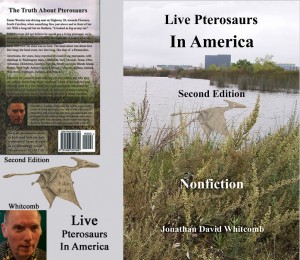Even recent criciticms (for example, by the paleontologist Darren Naish) of living-pterosaur research sometimes includes the insinuation of misidentification regarding bats, especially the fruit bat called “flying fox.” A typical sighting of a large long-tailed pterosaur, however, differs greatly from a sighting of a Flying Fox fruit bat. For one thing, at least some critics fail to realize how many sightings of apparent pterosaurs are in locations where this Megabat does not live.
Georgia Pterosaur (from the cryptozoology book Live Pterosaurs in America)
The lady . . . had been trying to find someone who might help her verify the existence of the strange animals that she had seen twice in the past few weeks. . . . Her first sighting was at 7 a.m., the second, 9 a.m., with both mornings overcast. . . .
Fifteen miles of her commute is on a two-lane 55-mph road through woods alternating with pastures . . . on August 27, 2008. She had woken up early and could not get back to sleep, so she left her house at 6:45 a.m., with the sky still overcast from the last remnants of [a] storm. . . . She had driven less than ten miles, just leaving an area of pasture, entering an area of thick woods . . . when an animal suddenly flew from the right, just over the front of her car. Although alone, she yelled, “What the — what — what is that?” She was stunned.
. . . It was the tail; she looked up at a “very long” tail that had a strange shape at the end. . . . a thick almost-heart-shape at the end of the tail . . . “Dive-bombing my car,” is how she described the flight path, as it crossed the highway in front of and slightly above her. “Curved, like a hammer,” is how she described the head, which had a crest that she thought was “solid, not feathery at all.” . . . a smoothly curved head crest.
Obviously what the lady saw near Winder, Georgia, in the summer of 2008, was no Flying Fox fruit bat, even if that species of Megabat lived in Georgia, which it does not. So what about sightings in Papua New Guinea, where those bats live in great numbers?
The cryptid seen in New Guinea, by Duane Hodgkinson in 1944 and by Brian Hennessy in 1971, I have named “Hodgkinson-Hennessy Ropen.” Similarities between the descriptions given to me by these two eyewitnesses struck me as too much for coincidence. . . .
. . . these different lengths of head crest I believe fall within the range of eyewitness error. In other words, the creatures observed by these two men could very well have had the same length of head crest (relative to the size of the head) . . . it seems likely that the species is the same for the 1944 and 1971 sightings.
Both Duane Hodgkinson and Brian Hennessy were struck by the long pterosaur tail . . . in a manner of speaking, and Hodgkinson was close enough to make an estimate of tail-length: “at least ten or fifteen feet.” It was obviously not any Flying Fox fruit bat.
Her sighting [Patty Carson] confirms the credibility of the eyewitness Eskin Kuhn, who long ago reported his 1971 encounter. But Patty saw a similar creature in 1965 . . .
Kuhn sketched what he had seen, soon after his sighting (obviously no fruit bat):




